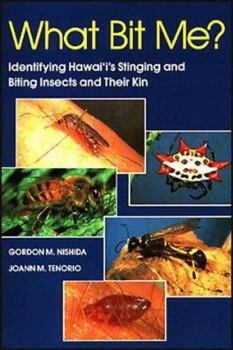What Bit Me?: Identifying Hawai'i's Stinging and Biting Insects and Their Kin
Select Format
Select Condition 
Book Overview
This reference covers the stinging and biting insects, spiders, mites, ticks, and their relatives commonly encountered by humans and pets in Hawai'i. In language understandable by nonscientists, the authors explain the history, life cycle, structure, and venoms and toxins known for each pest species. They provide descriptions to help you recognize what has bitten or stung you and to help you distinguish insects that are nuisances from those that are...
Format:Paperback
Language:English
ISBN:0824814924
ISBN13:9780824814922
Release Date:January 1993
Publisher:University of Hawaii Press
Length:72 Pages
Weight:0.50 lbs.
Dimensions:0.3" x 6.0" x 9.0"
Customer Reviews
1 rating
Ouch!
Published by Thriftbooks.com User , 16 years ago
Unfortunately, this book needs to be updated, because since it was published in 1993, several new biting arthropods have been imported into Hawaii. The stinging nettle caterpillar is a particularly obnoxious newcomer. Not that's its sting is so bad, but it can be hard to evade in the rainy parts of the island. Anyhow, residents and visitors to Hawaii can be thankful. Compared to the rest of the world, there aren't that many obnoxious insects and similar critters. We could have gotten along just fine without the centipedes and mosquitoes, thanks, but so far (cross fingers), there are no chiggers. Still, there are quite a few bugs that bite, pierce, inject poison or die and turn into allergy-inducing dust. Oahu enjoys a greater variety of nasty arthropods than any other island, thanks to its international airport and busy seaport. Circumstances count, too. Authors Gordon Nishida and JoAnn Tenorio write, "It is important to note that arthropods that sometimes threaten us were not specifically designed to hurt us." Besides bothering humans, many of them are useful, too, since they prey on other nuisances, pollinate flowers, break down organic matter etc. Not too many pernicious arthropods in the islands are life-threatenong. To ultrasensitive people, the honey bee can be a killer. The brown violin spider, a close relative of the brown recluse that terrorizes warm Mainland states, has a bite that doesn't usually kill, just makes you want to die for a while. The black widow can kill if bites are not treated. But the potential for much worse problems is not far off. Hawaii has the yellow fever mosquito, but no yellow fever; and the forest day mosquito, which transmits dengue fever. There was a brief dengue outbreak on Maui since this book was published. Quick government reaction to clean up mosquito areas eradicated dengue (again), but no doubt it will be reintroduced from time to time. (There was a dengue epidemic during World War II, associated with GIs coming back from the South Pacific; the source of the latest event was never pinpointed.) Hawaii has fleas, and it used to have bubonic plague. Nishida and Tenorio have written a handy guide to all these critters, at least as identified through 1993. Nishida was in charge of 13.5 million bugs (all dead) at the Bishop Museum Department of Entomology. Tenorio was a former acarologist (mites and ticks) at the museum. The bugs may be nasty but some of the color illustrations in this little volume are beautiful.






